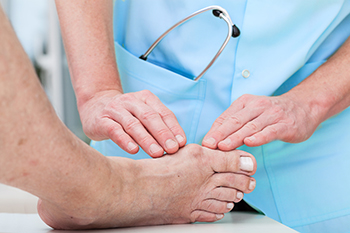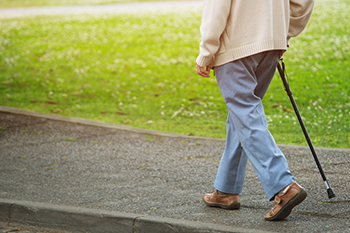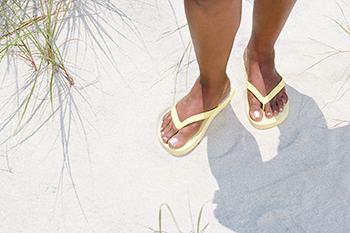Items filtered by date: August 2023
Types of Bunion Surgery

Bunions, those bony protrusions at the base of the big toe, can escalate from a minor inconvenience to a significant source of pain and discomfort over time. Fortunately, bunion surgery can help to alleviate pain and restore proper alignment of the big toe. Success rates hover around 85%, but perfect alignment and painlessness aren't guaranteed. Reduced joint flexibility, stiffness, and minor foot shortening are potential outcomes. Several surgery types exist, tailored to the severity of the bunion. Osteotomy, a common approach, involves cutting and realigning the bone. Soft tissue realignment may accompany this procedure. Arthrodesis fuses bones in the big toe joint, an option for severe deformities or advanced joint deterioration. Excision arthroplasty removes the bunion and a section of bone, creating a healing false joint. Following surgery, swelling is to be expected for several months. Elevation, crutches, and specially designed shoes will be essential during recovery, which may last approximately six months. If you have a bunion that is impeding you from performing your daily activities, it is suggested that you make an appointment with a podiatrist who can recommend the best treatment options for you.
If you are suffering from bunion pain, contact one of our podiatrists of Manhattan Footcare. Our doctors can provide the care you need to keep you pain-free and on your feet.
What Is a Bunion?
Bunions are painful bony bumps that usually develop on the inside of the foot at the joint of the big toe. As the deformity increases over time, it may become painful to walk and wear shoes. Women are more likely to exacerbate existing bunions since they often wear tight, narrow shoes that shift their toes together. Bunion pain can be relieved by wearing wider shoes with enough room for the toes.
Causes
- Genetics – some people inherit feet that are more prone to bunion development
- Inflammatory Conditions - rheumatoid arthritis and polio may cause bunion development
Symptoms
- Redness and inflammation
- Pain and tenderness
- Callus or corns on the bump
- Restricted motion in the big toe
In order to diagnose your bunion, your podiatrist may ask about your medical history, symptoms, and general health. Your doctor might also order an x-ray to take a closer look at your feet. Nonsurgical treatment options include orthotics, padding, icing, changes in footwear, and medication. If nonsurgical treatments don’t alleviate your bunion pain, surgery may be necessary.
If you have any questions, please feel free to contact our offices located in Manhattan and Brooklyn, NY . We offer the newest diagnostic and treatment technologies for all your foot care needs.
It's Time for Beautiful Feet
Fall Causes for Seniors and Prevention Strategies

For seniors, falls can pose serious risks to both physical health and independence. Understanding the underlying causes is pivotal in designing effective prevention strategies. Factors consisting of muscle weakness, poor balance, and reduced vision can play a significant role. Medication side effects, particularly dizziness or drowsiness, can also contribute to falling. Additionally, hazardous home environments, clutter, and uneven surfaces also heighten the risk. There are methods that can be implemented to prevent falling. Engaging in a regular exercise routine can help to enhance strength and balance. Vision checks and reviewing medications with a healthcare provider can be beneficial in reducing risks. Modifying the home environment by installing handrails, improving lighting, and reducing clutter fosters safety. By addressing these causes and adopting preventive measures, seniors can confidently navigate life while minimizing the risk of falls. If you would like more information about effective fall prevention techniques, it is suggested that you confer with a podiatrist.
Preventing falls among the elderly is very important. If you are older and have fallen or fear that you are prone to falling, consult with one of our podiatrists from Manhattan Footcare. Our doctors will assess your condition and provide you with quality advice and care.
Every 11 seconds, an elderly American is being treated in an emergency room for a fall related injury. Falls are the leading cause of head and hip injuries for those 65 and older. Due to decreases in strength, balance, senses, and lack of awareness, elderly persons are very susceptible to falling. Thankfully, there are a number of things older persons can do to prevent falls.
How to Prevent Falls
Some effective methods that older persons can do to prevent falls include:
- Enrolling in strength and balance exercise program to increase balance and strength
- Periodically having your sight and hearing checked
- Discuss any medications you have with a doctor to see if it increases the risk of falling
- Clearing the house of falling hazards and installing devices like grab bars and railings
- Utilizing a walker or cane
- Wearing shoes that provide good support and cushioning
- Talking to family members about falling and increasing awareness
Falling can be a traumatic and embarrassing experience for elderly persons; this can make them less willing to leave the house, and less willing to talk to someone about their fears of falling. Doing such things, however, will increase the likelihood of tripping or losing one’s balance. Knowing the causes of falling and how to prevent them is the best way to mitigate the risk of serious injury.
If you have any questions, please feel free to contact our offices located in Manhattan and Brooklyn, NY . We offer the newest diagnostic and treatment technologies for all your foot care needs.
The Heels and Mobility

Various foot conditions can make movement difficult. Chief among them is cracked heels. As one ages, skin becomes thinner and dryer and the skin on the heels can form calluses, or dead skin, and can develop cracks. This often happens because the heels endure a lot of pressure from walking and the skin is dry. Cracked heels can become painful and make walking difficult. If they get bad enough, fissures can develop and the cracks deepen, can bleed, and be a breeding ground for infection. If one has diabetes, peripheral artery disease, or poor circulation, cracked heels can become serious foot wounds that are difficult to heal. Hydration and moisturizing the feet can help with cracked heels, as can wearing socks with cushioned shoes and temporarily cutting down on activities that put pressure on the heels. If you have cracked heels and the condition is causing you discomfort or it is worsening, it is strongly suggested that you make an appointment with a podiatrist who can make sure that is what you are dealing with and provide treatment.
If the skin on your feet starts to crack, you may want to see a podiatrist to find treatment. If you have any concerns, contact one of our podiatrists from Manhattan Footcare. Our doctors can provide the care you need to keep you pain-free and on your feet.
Cracked Heels
It is important to moisturize your cracked heels in order to prevent pain, bleeding, and infection. The reason cracked heels form is because the skin on the foot is too dry to support the immense pressure placed on them. When the foot expands, the dry skin on the foot begins to split.
Ways to Help Heal Them
- Invest in a good foot cream
- Try Using Petroleum Jelly
- Ease up on Soaps
- Drink Plenty of Water
Ways to Prevent Cracked Heels
- Moisturize After Showering
- Skip a Shower
- Keep Shower Water Lukewarm
- Don’t Scrub Your Feet
If you are unsure how to proceed in treating cracked heels, seek guidance from a podiatrist. Your doctor will help you with any questions or information you may need.
If you have any questions, please feel free to contact our offices located in Manhattan and Brooklyn, NY . We offer the newest diagnostic and treatment technologies for all your foot care needs.
Flip Flops Can Cause Dangers to the Feet

Flip flops are a staple during the warmer months, offering ease and convenience. However, beneath their carefree appeal lies a hidden danger to foot health. Most flip-flops lack support, which may lead to overpronation, causing strain on the feet and ankles. Additionally, the toes constantly grip the flip-flops to keep them on the feet, leading to muscle imbalance and painful conditions like plantar fasciitis. The flimsy structure of flip-flops may also lead to accidents or injuries. Many people have found their gait, or walking pattern, has been altered by wearing flip flops, which may lead to calluses forming on the soles of the feet. While occasional use may be okay, prolonged wear of flip-flops is said to be detrimental to foot health. More supportive footwear can protect your feet and maintain their well-being. It is suggested that you speak to a podiatrist if you would like additional information about the negative impact of wearing flip-flops.
Flip-flops are not always the best choice of footwear. If you have any concerns about your feet or ankles, contact one of our podiatrists from Manhattan Footcare. Our doctors will assist you with all of your foot and ankle needs.
Flip-Flops and Feet
When the weather starts warming up, people enjoy wearing flip-flops. Flip-flops are comfortable, stylish, and easy to slip on and off; they're perfect for any summer beach goer. However, these shoes can cause harm to the feet.
How Can Flip-Flops Affect Me Long-Term?
- Ankle problems
- Hip problems
- Lower back problems
- Pain in the balls of the feet
- Problems with foot arches
- Changes in the way you walk
Are There Injuries Associated with Flip-Flops?
Yes. Since flip-flops are relatively weak and do not provide the same amount of support as sneakers, people who wear flip-flops regularly are more susceptible to injuries. On top of that, the open nature of the shoe makes your feet more prone to other problems, such as cuts and even infections. Common injuries and ailments include:
- Sprained ankles
- Blisters
- Infections
- Cuts and Scrapes
I like Wearing Flip-Flops. Are There Safe Alternatives?
When buying flip-flops, try to find ones that have sturdy soles and that are made of high-quality materials that will support for your feet. These flip-flops will cost more but will also last longer as a result.
If you have any questions please feel free to contact our offices located in Manhattan and Brooklyn, NY . We offer the newest diagnostic and treatment technologies for all your foot and ankle needs.
Running After Enduring a Broken Ankle

Normal activity can resume after an ankle fracture, despite it taking considerable time. A broken ankle can happen from falling, or if something heavy drops on the leg. Immediate symptoms can include bruising, swelling, and it is difficult, if not impossible to walk. Prompt medical attention is often sought, and having an X-ray performed can provide an accurate diagnosis. Once confirmed, a protective boot or cast is worn that can provide stability and mobility while the healing process occurs. Many people who run may be concerned about resuming their running or jogging routine after fracturing their ankle. There are specific stretches that can be done which may help to increase ankle strength and range of motion. When these are frequently performed, the average time for people to start running again may be between three and four months. This can depend on whether surgery was performed, how severe the fracture is, and the amount of effort that is put into doing all that is possible to have a healed ankle. If you have fractured your ankle, it is suggested that you confer with a podiatrist who can help you to heal successfully.
Broken ankles need immediate treatment. If you are seeking treatment, contact one of our podiatrists from Manhattan Footcare. Our doctors can provide the care you need to keep you pain-free and on your feet.
Broken Ankles
A broken ankle is experienced when a person fractures their tibia or fibula in the lower leg and ankle area. Both of these bones are attached at the bottom of the leg and combine to form what we know to be our ankle.
When a physician is referring to a break of the ankle, he or she is usually referring to a break in the area where the tibia and fibula are joined to create our ankle joint. Ankles are more prone to fractures because the ankle is an area that suffers a lot of pressure and stress. There are some obvious signs when a person experiences a fractured ankle, and the following symptoms may be present.
Symptoms of a Fractured Ankle
- Excessive pain when the area is touched or when any pressure is placed on the ankle
- Swelling around the area
- Bruising of the area
- Area appears to be deformed
If you suspect an ankle fracture, it is recommended to seek treatment as soon as possible. The sooner you have your podiatrist diagnose the fracture, the quicker you’ll be on the way towards recovery.
If you have any questions, please feel free to contact our offices located in Manhattan and Brooklyn, NY . We offer the newest diagnostic and treatment technologies for all your foot care needs.


